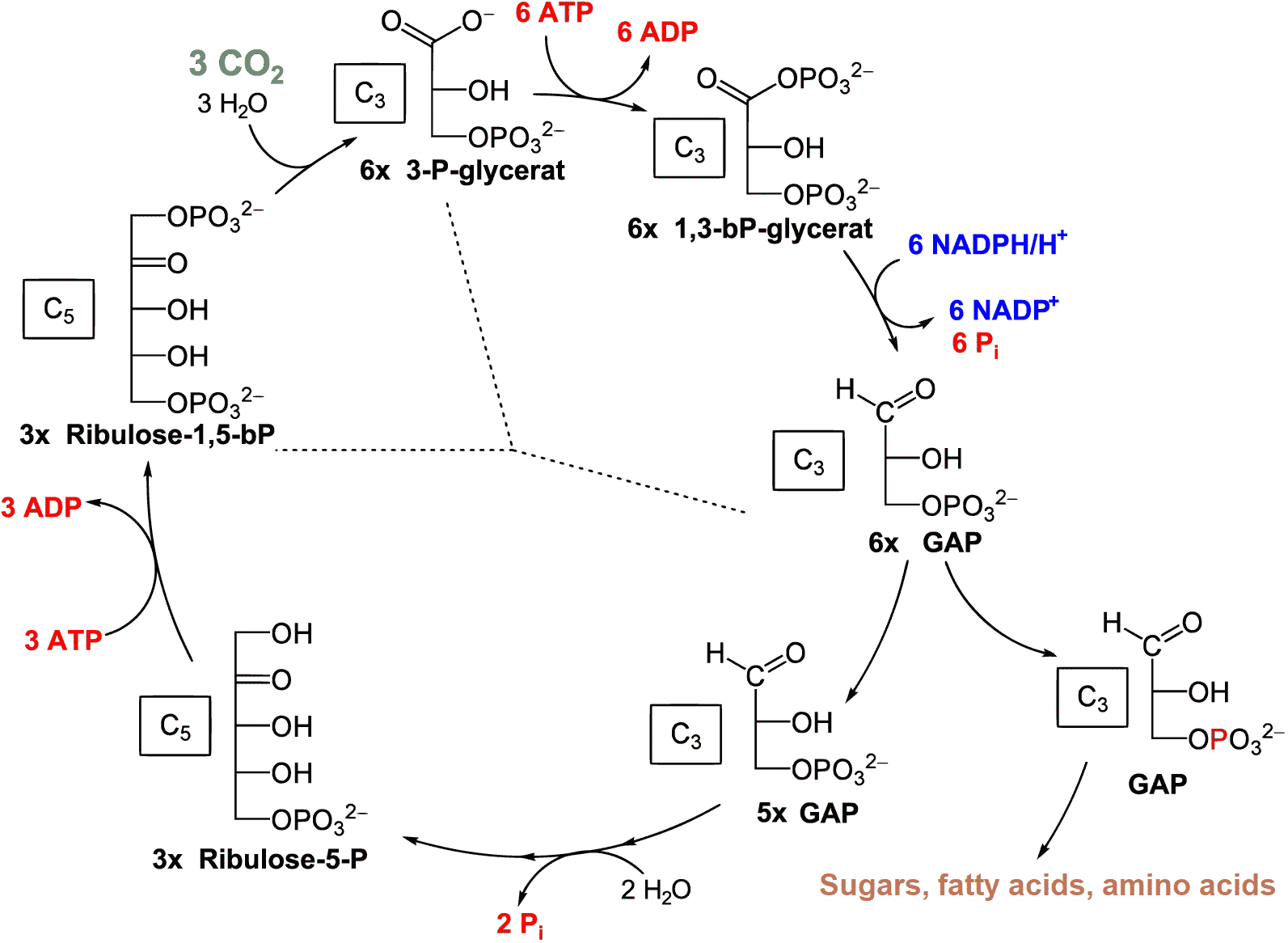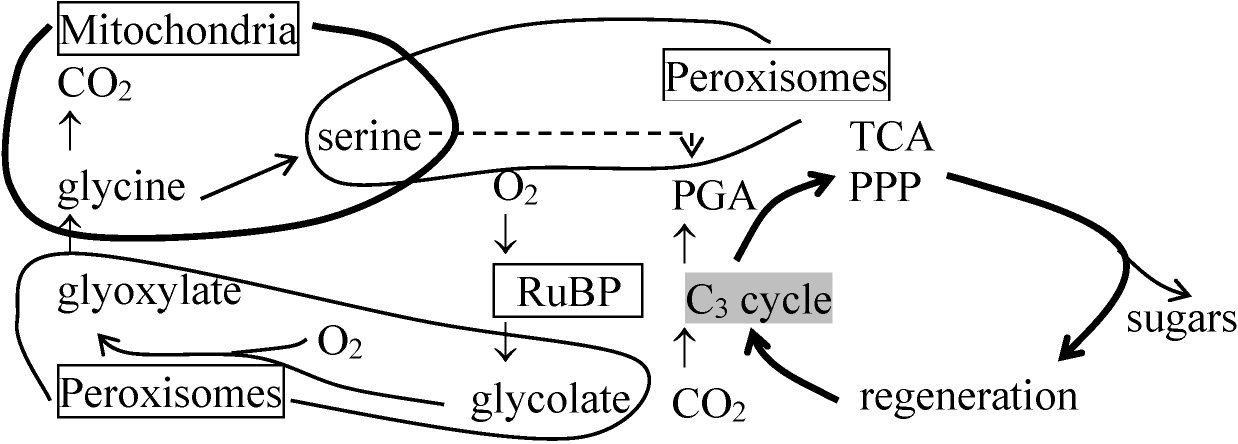(Upload on September 21 2023) [ 日本語 | English ]
Mount Usu / Sarobetsu post-mined peatland
From left: Crater basin in 1986 and 2006. Cottongrass / Daylily
HOME > Lecture catalog / Research summary > Glossary > Photosynthesis
Life is woven from the air by lightThat is the conversion from light energy to chemical energy (stocked into carbohydrates, represented by glucose, sucrose and starch) by green plants.Equation6CO2 + 12H2O + [solar energy] → C6H12O6 + 6O2 + 6H2Ocarbon dioxide + water + [solar energy] → glucose + oxygen + water Do not understand by the simplified equation. You can not understand why water is important, although you might learn this equation when you were in high school. 6CO2 + 6H2O + [solar energy] → C6H12O6 + 6O2 Characteristics of photosynthesis on terrestrial vascular plants CO2, 6 moles = 134.4 liters at standard temperature and pressure Fig. Photosynthesis for making budgetVisible light (solar radiation) → absorbed by leavesWater → absorbed from soil (土壌) (or water) by roots (根) |
[ metabolism ] |
Calvin(-Benson) cycle (カルビン(=ベンソン)回路)= reductive pentosephosphate cycle (還元的ペントースリン酸回路)= photosynthetic carbon reduction, PCR (光合成的炭素還元回路) = C3 cycle (C3回路)  Three molecules of CO2 fixed give a net yield of one molecule of glyceraldehyde 3-phosphate at a net cost of nine molecules of ATP and six molecules of NADPH. |
ribulose-1, 5-bP (ribulose 1, 5-bisphosphate) 5C |
|
Photosynthesis requires the efficient capture of light whilst avoiding the absorption of damaging excess energy. Light absorption can be optimised by plant growth, the movement of leaves and the movement of chloroplasts within leaves. To grow optimally, plants must achieve a balance between the capture of light and the uptake of other resources. Plants living in shaded conditions have adaptations to efficiently capture light including increased shoot:root ratios, thin leaves and high chlorophyll concentrations. Both C4 and CAM involve a separation of CO2 absorption and fixation: C4 spatially and CAM temporally. If a plant is to survive, grow and reproduce, it must make a net gain in carbon, that is, carbon gained through photosynthesis must be greater than carbon lost through respiration. Photosynthesis makes a significant contribution to carbon uptake from the atmosphere and may go some way to offsetting atmospheric increases due to human activity. |
Understanding the effects of global warming on photosynthesis is complex but necessary to fully understand the consequences of climate change.
Nitrogen assimilation and photosynthesis (窒素同化と光合成)Eq. Specific leaf area, SLA = A/WL (m2/g)the ratio of leaf area to leaf dry mass
A: the area of a given leaf (or all leaves of a plant) = leaf mass ratio, LMR, or leaf weight fraction, LWF Eq. Leaf mass area, LMA = 1/SLA = WL/A (g/m2)formerly called specific leaf weight, SLW Photosynthetic nitrogen-use efficiency (PNUE)the ratio of CO2 assimilation rate to leaf organic nitrogen content |
To reduce photorespiration, C3 plants → C4 plantsC3 plant (C3植物)photorespiration present (Calvin cycle)spinach, peanuts, cotton, wheat, rice, barley and most trees and grasses  Photosynthetic metabolism in the chloroplasts of C3 plants. 1,3BPG, bisphosphoglycerate; G-3-P, glyceraldehyde 3-phosphate; DHAP, dihydroxyacetone phosphate; F-1,6-P, fructose 1,6-bisphosphate; F-6-P, fructose 6-phosphate; X-5-P, xylose 5-phosphate; E-4-P, erythrose 4-phosphate; S-1,7-P, sedoheptulose 1,7-bisphosphate; S-7-P, sedoheptulose 7-phosphate C4 plant (C4植物)= Hatch-Slack pathway (Hatch & Slack 1966)photorespiration absent |
Table. Characteristics of photosynthetic parameters on C4 plants. C4 plants Sjoa-bean Sunflower Sugar-beat Tobacco Corn Optimal temperature (°C) 26 25 25 25 35 O2 fixation (CO2 mg/dm2/h) 35 28 25 11 55 Photorespiration (lost O2 %) 46 27 47 55 0 + sugar cane, millet, sorghum, pineapple, daisies, cabbage, etc. CAM plant (CAM植物)= crassulacean acid metabolismcacti, sedum, jade, orchids and agave Instead of separating the light-dependent reactions and the use of CO2 in the Calvin cycle in space, CAM plants separate these processes in time (night and day). ____________↓CO2 Night: PEP →→→→→ oxaloacetete →→→ malate ______↑ PEP carboxylase______________or other organic acids ______↑_______________________________↓ ______←←←←←←←←←←←←←←←←←← __________________↓ Day:_____________ CO2 __________________↓ Rubisco ______________Calvin cycle _______sugars ←↑______↓ _______________←←←← Glyconeogenesis (糖新生)Def. a shunt for the synthesis of sugars such as glucose and glycogen from substances other than sugars (☛ glyoxylate cycle)
carbohydrates → sugar phosphate and sugar nucleotide |
|
Light-induced reduction in the photosynthetic capacity of a plant, alga, and cyanobacterium ≈ light-induced damage to PSII ∵ photosystem II (PSII) is most sensitive |
Pulse amplitude modulation, PAM(パルス変調蛍光測定) |
SPAD= Soil and Plant Analyzer DevelopmentSPAD ∝ chlorophyll content (within a species) red LED: emission central wavelength = 650 nm
→ absorbed by chlorophyll |